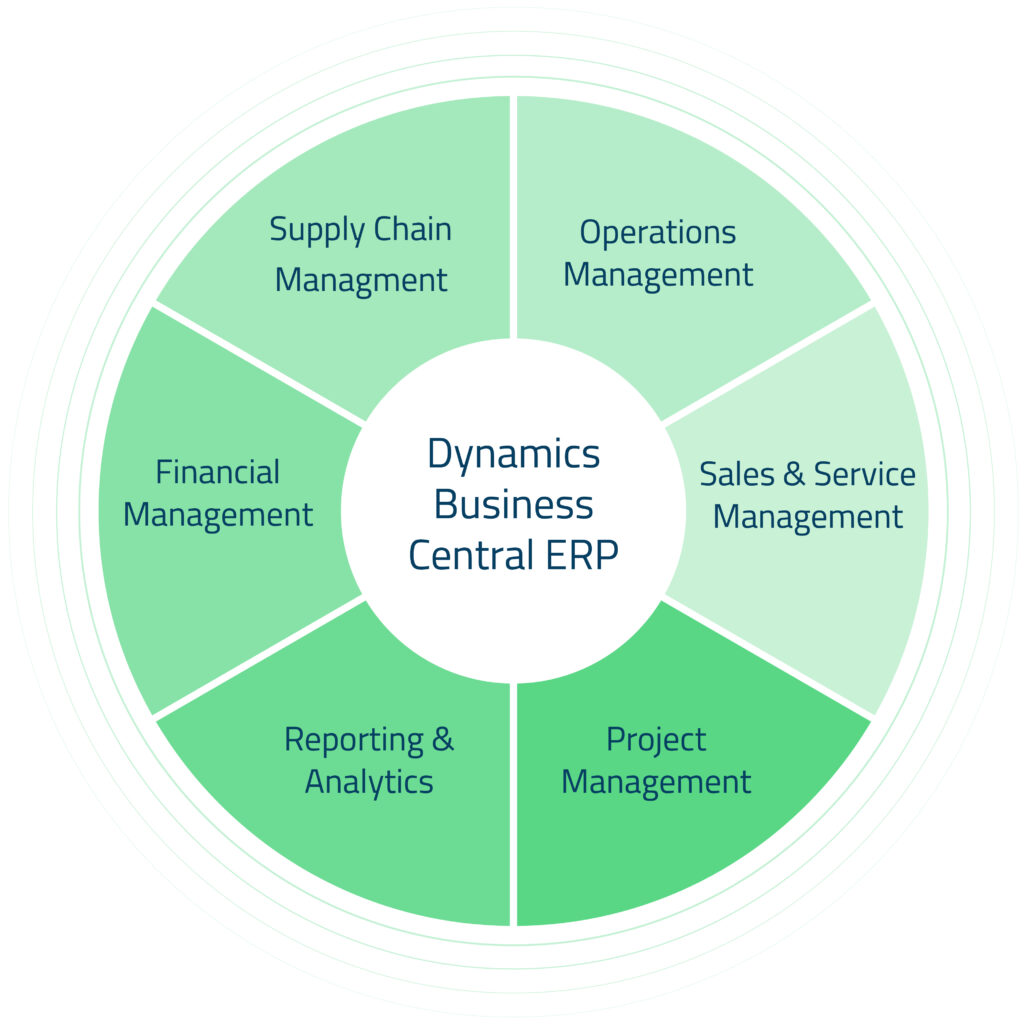Microsoft Dynamics 365 Business Central
Microsoft Dynamics 365 Business Central is the All-in-one solution to connect your business
Business Central is a single, comprehensive ERP solution to meet the needs of growing small and medium-sized businesses
Benefits of Connecting your financials, sales, service and operations
Increase financial visibility: Accelerate financial close, chart financial performance in real time, and improve forecast accuracy while maintaining compliance and security
Optimise your supply chain: Maximise profitability with an end-to-end view across operations, purchasing, manufacturing, stock, and warehouse management
Boost sales and improve service: Manage the sales process from start to finish within Outlook and deliver exceptional service with a connected view of customers and service operations
Deliver projects on time and under budget: Plan and monitor your projects with real-time metrics on resources, profitability, tasks, and progress
The Business Central Solution
Microsoft Dynamics Business Central ERP works in all key industries and drives business efficiency by streamlining your business processes. Use Business Central to integrate your existing software so you have a single view of your key processes enabling you to make better, more informed decisions based on real-time, up-to-date data.
ProStrategy partner with Microsoft Dynamics to provide customers with best-in-class ERP software. Microsoft Dynamics 365 Business Central / Nav is a versatile, user friendly system that will help you achieve your strategic business goals. We have delivered ERP projects across a wide range of industries, we know what it takes to ensure your project is a success!


Could this solution help you and your business?
- Basic General Ledger – Set up a company and start posting to the general ledger, chart of accounts, general journals, VAT facilities, recurring journals, and source codes.
- Budgets – Work with budgets in general ledger accounts.
- Deferrals – Set up deferral templates that automate the process of deferring revenues and expenses over a pre-defined schedule.
- Fixed Assets – Keep track of fixed assets and related transactions such as acquisitions, depreciations, write-downs, appreciations and disposals.
- Receivables – Post sales transactions in journals and manage receivables; register customers and manage receivables using general journals.
- Audit Trails – The system automatically assigns audit trails and posting descriptions to every transaction. In addition, users can define reason codes to create complementary audit trails.
- Bank Account Management – Create, operate, and manage multiple bank accounts for catering to your diverse business needs and across different currencies.
- Reconciliation – Reconcile your bank statement data automatically to open bank account ledger entries end keep track of all your bank statements.
- Dimensions – Add unlimited dimensions to any ledger for advanced transaction analyses.
- Currencies – Manage multiple currencies throughout the system, including payables and receivables, general ledger reports, resource and inventory items, and bank accounts.
- Production Orders – Create and manage production orders and post consumption and output to the production orders.
- Version Management – Create and manage different version of the manufacturing bill of materials and routings.
- Agile Manufacturing – Plan rush hours, make exceptions, and handle last-minute changes to your processes with multiple planning options.
- Supply Planning – Plan for material requirements based on demand, with support for master production scheduling and materials requirements planning.
- Demand Forecasting – Plan and create production and purchase orders, taking into consideration the demand forecast together with the level of available inventory and parameters of requirement planning.
- Capacity Planning – Add capacities to the manufacturing process. Set up routings and use these routings on production orders and in material requirements planning.
- Machine Centres – Manage capacity on several levels; on a more detailed level for machine centres and on a consolidated level for work centers.
- Finite Loading – Take capacity constraints into account so that no more work is assigned to a work center than the capacities can be expected to execute during a given time period.
- Subcontracting – Allows companies to send raw materials, unfinished goods, or partially finished goods for further processing elsewhere.
- Resources – Register and sell resources, combine related resources into one resource group, or track individual resources.
- Estimates – Monitor resource usage and get a complete overview of your capacity for each resource with information about availability and planned costs on orders and quotes.
- Jobs – Keep track of usage on jobs and data for invoicing the customer. Manage both fixed-price jobs and time-and-materials jobs.
- Time Sheets – Time sheets are a simple and flexible solution for time registration with manager approval and integrate with Service, Jobs and Resources.
- Multiple Languages – Switch languages on the client in real time, provided that the desired language is available.
- Reason Codes – Define a set of reason codes that can be assigned to individual transactions throughout the system, providing user-defined audit trails.
- Extended Text – Set up an unlimited number of lines to describe inventory items, resources and general ledger accounts.
- Intrastat Reporting – Automatically retrieve the necessary data to report Intrastat information to statistics authorities. Local customs authorities can inform you whether your company is obligated to file such a report.
- Outlook Integration – Synchronize your to-do items and your contacts with your meetings, tasks, and contacts in Outlook.
- Sales Order Management – Manage sales orders, blanket sales orders, and sales order processes.
- Purchase Order Management – Manage purchases, blanket orders, and purchase order processes.
- Locations – Manage inventory in multiple locations that may represent a production plant, distribution center, warehouse, showroom, retail outlet or service car.
- Item Transfers – Track inventory as it’s moved from one location to another and account for the value of inventory in transit at various locations.
- Warehouse Management – Warehouse functionality in Business Central can be implemented in different complexity levels, depending on a company’s processes and order volume.
- Assembly Management – To support companies that supply products to their customers by combining components in simple processes without the need of manufacturing functionality, Business Central includes features to assemble items that integrate with existing features, such as sales, planning, reservations, and warehousing.
- Service Orders – Register your after-sales issues including service requests, services due, service orders, and repair requests.
- Service Price Management – Set up, maintain, and monitor your service prices.
- Service Item Management – Record and keep track of all your service items, including contract information, component management, and BOM reference and warranty information.
- Service Contract Management – Record details on service levels, response times, and discount levels, as well as on the service history of each contract, including used service items and parts and labor hours.
- Planning – Assign personnel to work orders and log details such as work order handling and work order status.
- Dispatching – Manage service personnel and field technician information, and filter according to availability, skills, and stock items.
- Contacts – Maintain an overview of your contacts and record your contact information for all business relationships.
- Campaigns – Organize campaigns based on segments of your contacts that you define.
- Opportunity Management – Keep track of sales opportunities, section your sales processes into different stages, and use this information to manage your sales opportunities.
- Dynamics 365 for Sales Integration – Integrate with Dynamics 365 for Sales in a few easy steps to synchronize your data, including sales orders, item availability, units of measure, and currencies.
- Employees – Group and track employee information and organize employee data according to different types of information, such as experience, skills, education, training, and union membership.
- Expense Management – Post expenses against employee cards to track and reimburse their expenses.
ERP Add-ons
Connect your financials, sales, services and operations with Dynamics 365 Business Central enhancements.



